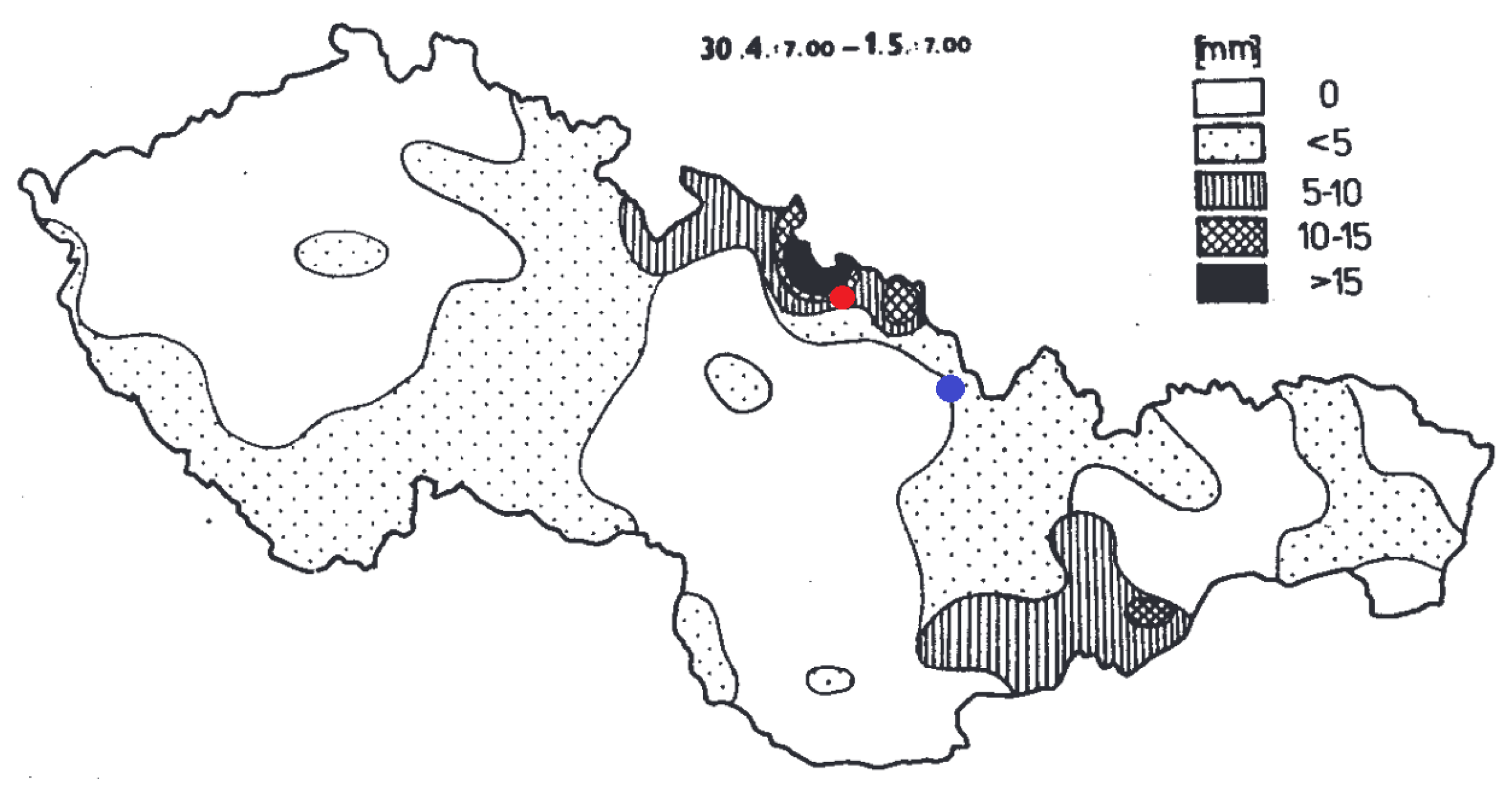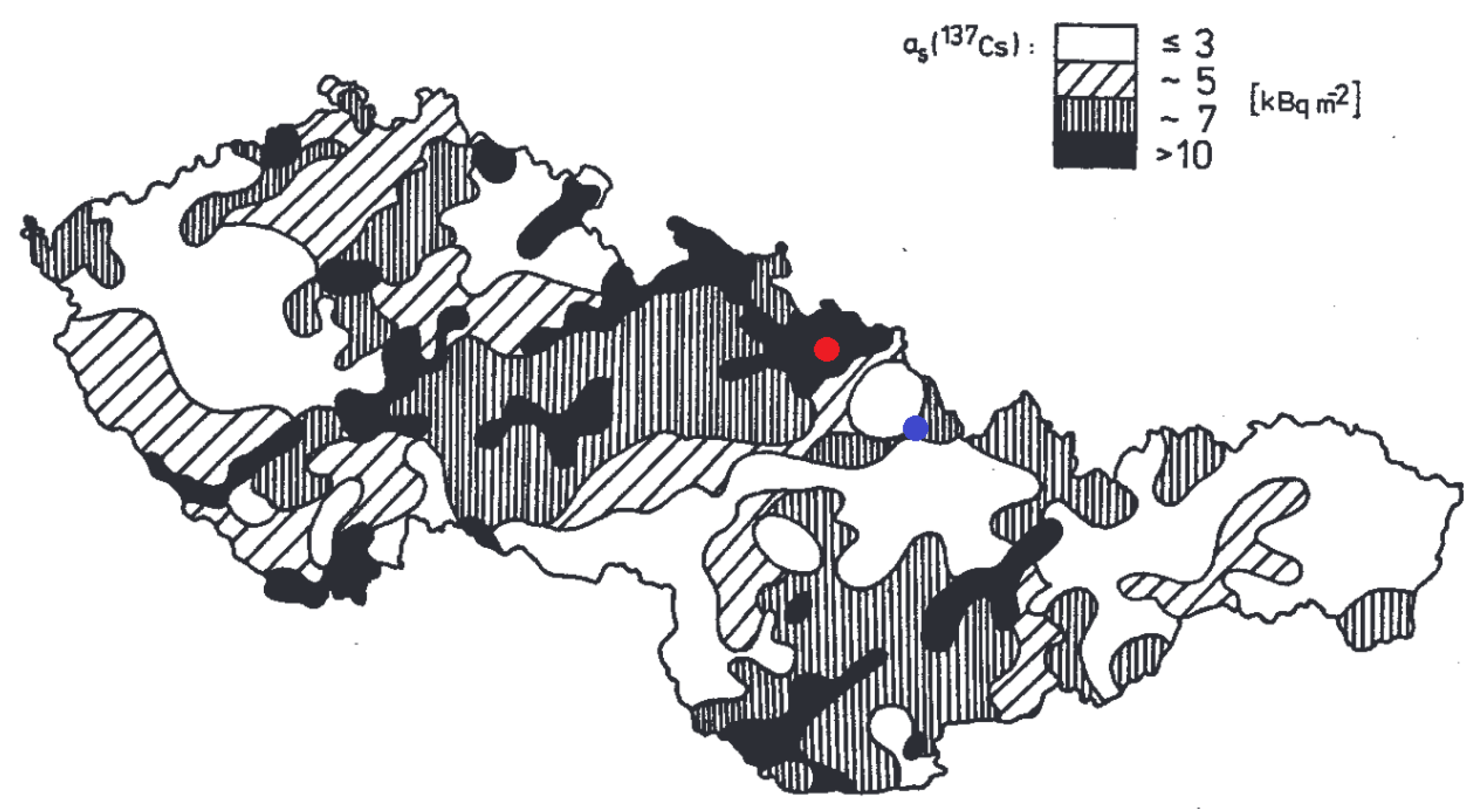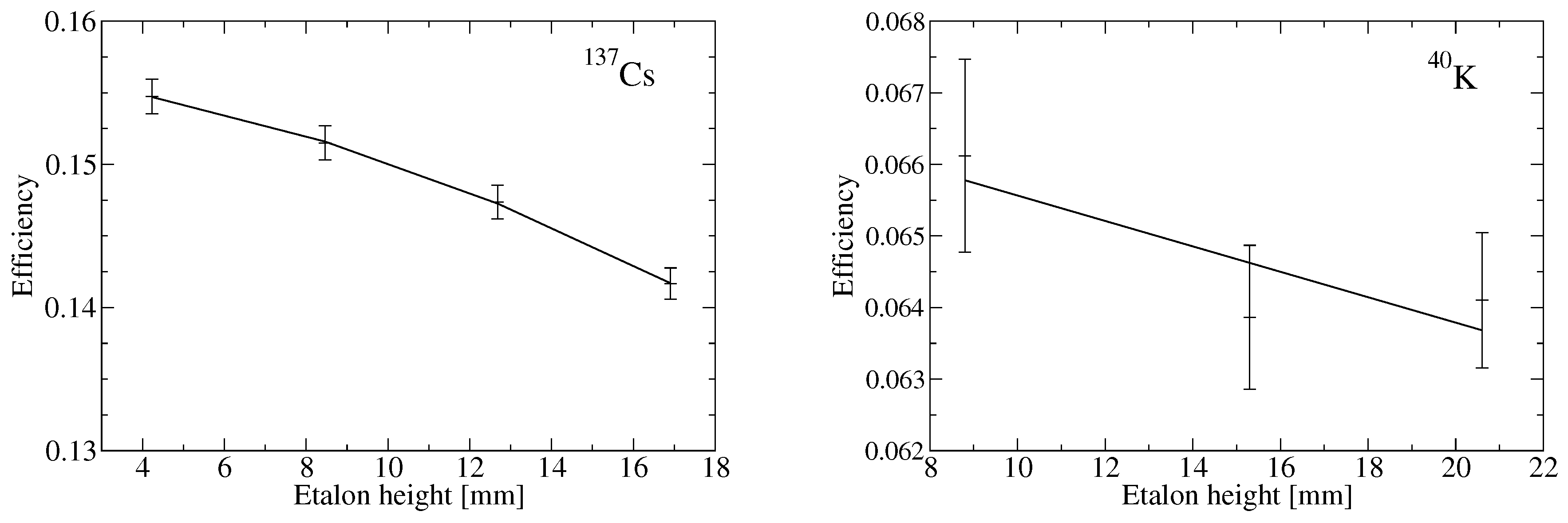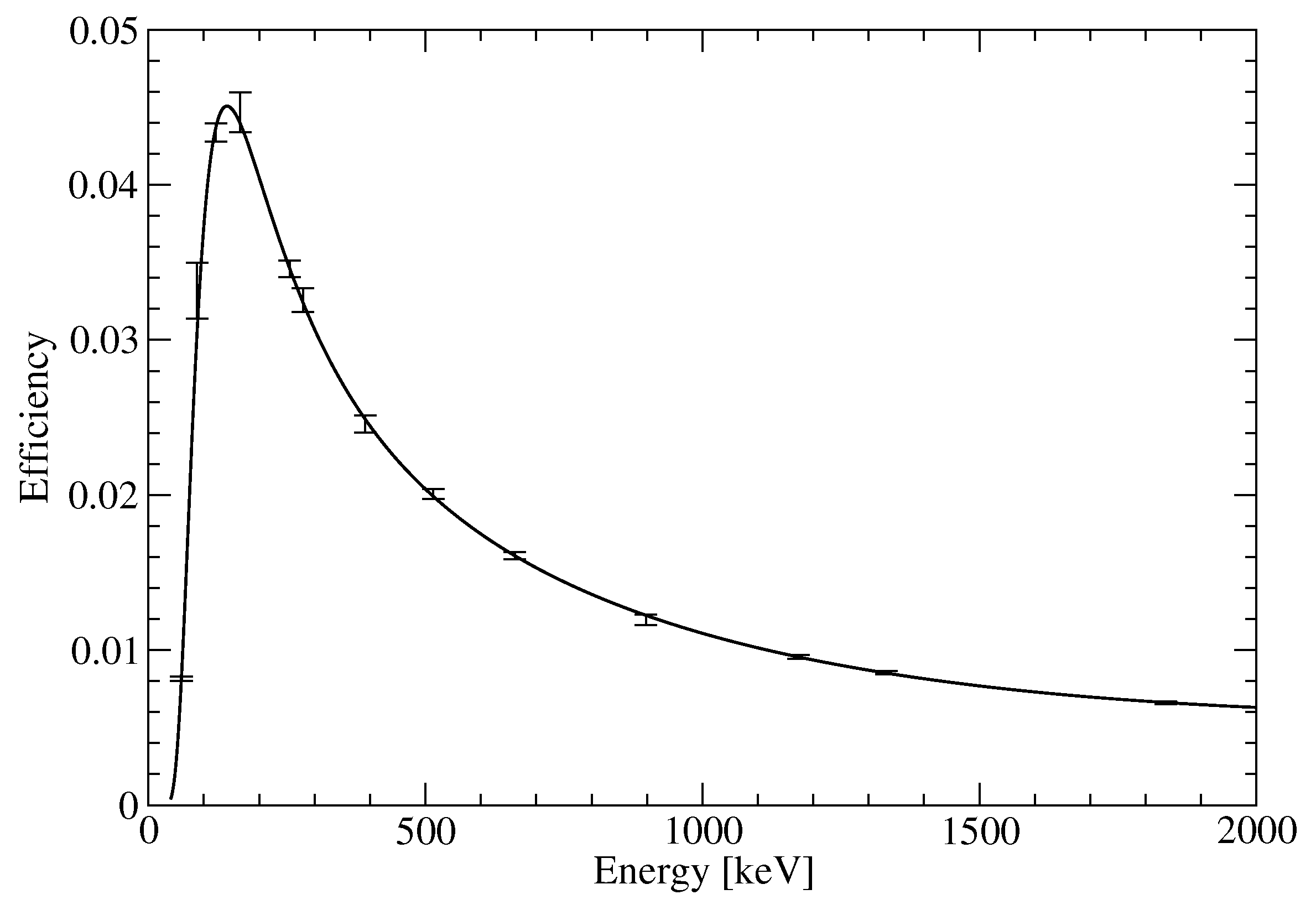Radiocaesium Contamination of Mushrooms at High- and Low-Level Chernobyl Exposure Sites and Its Consequences for Public Health
Abstract
:1. Introduction
2. Materials and Methods
3. Results and Discussion
4. Conclusions
Author Contributions
Funding
Institutional Review Board Statement
Informed Consent Statement
Data Availability Statement
Acknowledgments
Conflicts of Interest
Abbreviations
| IAEA | International Atomic Energy Agency |
| GPS | Global Positioning System |
| CET | Central European Time |
| OFE-OK | Oxygen Free Copper of Very High Purity |
| HPGe | High Purity Germanium Spectrometer |
References
- Bazala, M.A.; Bystrejewska-Piotrowska, G.; Čipáková, A. Bioaccumulation of 137Cs in wild mushrooms collected in Poland and Slovakia. Nukleonika 2005, 50 (Suppl. S1), 15–18. [Google Scholar]
- Falandysz, J.; Saniewski, M.; Fernandes, A.R.; Meloni, D.; Cocchi, L.; Struminska-Parulska, D.; Zalewska, T. Radiocaesium in Tricholoma spp. from the Northern Hemisphere in 1971–2016. Sci. Total Environ. 2022, 802. [Google Scholar] [CrossRef]
- Guillen, J.; Baeza, A. Radioactivity in mushrooms: A health hazard? Food Chem. 2014, 154, 14–25. [Google Scholar] [CrossRef] [PubMed]
- Zarubina, N.E. The content of accidental radionuclides in mushrooms from the 30-km zone of Chernobyl Nuclear Power Station. Mikol. I Fitopatol. 2004, 38, 36–40. [Google Scholar]
- Beňová, K.; Dvořák, P.; Tomko, M.; Falis, M. Artificial environmental radionuclides in Europe and methods of lowering their foodstuff contamination—A review. Acta Vet. Brno 2016, 85, 105–112. [Google Scholar] [CrossRef] [Green Version]
- Bučina, I.; Dvořák, Z.; Malátová, I.; Vrbová, H.; Drábová, D. Radionuclides from the Chernobyl accident in soil over the Czechoslovak Territory, their origin, deposition and distribution. In Proceedings of the XV Regional Congress of IRPA, the Radioecology of Natural and Artificial Radionuclides, Visby, Sweden, 10–14 September 1989; pp. 170–175. [Google Scholar]
- Savino, F.; Pugliese, M.; Quarto, M.; Adamo, P.; Loffredo, F.; De Cicco, F.; Roca, V. Thirty years after Chernobyl: Long-term determination of 137Cs effective half-life in the lichen Stereocaulon vesuvianum. J. Environ. Radioact. 2017, 172, 201–206. [Google Scholar] [CrossRef] [PubMed]
- Hashimoto, S.; Imamura, N.; Kawanishi, A.; Komatsu, M.; Obashi, S.; Nishina, K.; Kaneko, S.; Shaw, G.; Thiry, Y. A dataset of 137Cs activity concentration and inventory in forests contaminated by the Fukushima accident. Sci. Data 2020, 7, 431. [Google Scholar] [CrossRef]
- Ambrosino, F.; Stellato, L.; Sabbarese, C. A case study on possible radiological contamination in the Lo Uttaro landfill site (Caserta, Italy). J. Phys. Conf. Ser. 2020, 1548, 012001. [Google Scholar] [CrossRef]
- Červínková, A.; Poschl, M.; Pospíšilová, L. Radiocaesium transfer from forest soils to wild edible fruits and radiation dose assessment through their ingestions in Czech Republic. J. For. Res. 2017, 22, 91–96. [Google Scholar] [CrossRef]
- Ivanic, M.; Fiket, Z.; Medunic, G.; Turk, M.F.; Marovic, G.; Sencar, J.; Kniewald, G. Multi-element composition of soil, mosses and mushrooms and assessment of natural and artificial radioactivity of a pristine temperate rainforest system (Slavonia, Croatia). Chemosphere 2019, 215, 668–677. [Google Scholar] [CrossRef] [PubMed]
- Daillant, O.; Boilley, D.; Josset, M.; Hettwig, B.; Fischer, H.W. Evolution of radiocaesium contamination in mushrooms and influence of treatment after collection. J. Radioanal. Nucl. Chem. 2013, 297, 437–441. [Google Scholar] [CrossRef]
- Calmon, P.; Thiry, Y.; Zibold, G.; Rantavaara, A.; Fesenko, S. Transfer parameter values in temperate forest ecosystems: A review. J. Environ. Radioact. 2009, 100, 757–766. [Google Scholar] [CrossRef]
- Čipáková, A. Migration of radiocaesium in individual parts of the environment. Nukleonika 2005, 50, 19–23. [Google Scholar]
- IAEA. Intervention criteria in a nuclear or radiation emergency. In IAEA Safety Series No. 109; International Atomic Energy Agency: Viena, Austria, 1994. [Google Scholar]
- Čipáková, A. 137Cs content in mushrooms from localities in eastern Slovakia. Nukleonika 2004, 49, 25–29. [Google Scholar]
- Falandysz, J.; Zalewska, T.; Saniewski, M.; Fernandes, A.R. An evaluation of the occurrence and trends in 137Cs and 40K radioactivity in King Bolete Boletus edulis mushrooms in Poland during 1995–2019. Environ. Sci. Pollut. Res. 2021, 28, 405–415. [Google Scholar] [CrossRef]
- Zalewska, T.; Cocchi, L.; Falandysz, J. Radiocaesium in Cortinarius spp. mushrooms in the regions of the Reggio Emilia in Italy and Pomerania in Poland. Environ. Sci. Pollut. Res. 2016, 23, 169–174. [Google Scholar] [CrossRef] [PubMed] [Green Version]
- Heinrich, G. Distribution of Radiocesium in the different parts of mushrooms. J. Environ. Radioact. 1993, 18, 229–245. [Google Scholar] [CrossRef]
- Kocadag, M.; Exler, V.; Christopher, B.S.; Baumgartner, A.; Stietka, M.; Landstetter, C.; Korner, M.; Maringer, F.J. Environmental radioactivity study of Austrian and Bavarian forest ecosystems: Long-term behaviour of contamination of soil, vegetation and wild boar and its radioecological coherences. Appl. Radiat. Isot. 2017, 126, 106–111. [Google Scholar] [CrossRef] [PubMed]
- Kalač, P. A review of edible mushrooms radioactivity. Food Chem. 2001, 75, 29–35. [Google Scholar] [CrossRef]
- Horyna, J.; Řanda, Z. Uptake of radiocesium and alkali metals by mushrooms. J. Radioanal. Nucl. Chem. 1988, 127, 107–120. [Google Scholar] [CrossRef]
- Kita, K.; Igarashi, Y.; Kinase, T.; Hayashi, N.; Ishizuka, M.; Adachi, K.; Koitabashi, M.; Sekiyama, T.T.; Onda, Y. Rain-induced bioecological resuspension of radiocaesium in a polluted forest in Japan. Sci. Rep. 2020, 10, 15330. [Google Scholar] [CrossRef]
- Marovic, G.; Franic, Z.; Sencar, J.; Bituh, T.; Vugrinec, O. Mosses and Some Mushroom Species as Bioindicators of Radiocaesium Contamination and Risk Assessment. Coll. Antropol. 2008, 32, 109–114. [Google Scholar] [PubMed]
- Baeza, A.; Guillen, F.J.; Salas, A.; Manjon, J.L. Distribution of radionuclides in different parts of a mushroom: Influence of the degree of maturity. Sci. Total Environ. 2006, 359, 255–266. [Google Scholar] [CrossRef]
- Falandysz, J.; Zhang, J.; Saniewski, M. 137Cs, 40K and K in raw and stir-fried mushrooms from the Boletaceae family from the Midu region in Yunnan, Southwest China. Environ. Sci. Pollut. Res. 2020, 27, 509–517. [Google Scholar] [CrossRef] [PubMed]
- Falandysz, J.; Zalewska, T.; Fernandes, A.R. 137Cs and 40K in Cortinarius caperatus mushrooms (1996–2016) in Poland—Bioconcentration and estimated intake: 137Cs in Cortinarius spp. from the Northern Hemisphere from 1974 to 2016. Environ. Pollut. 2019, 255, 113208. [Google Scholar] [CrossRef] [PubMed]
- Falandysz, J.; Saniewski, M.; Zhang, J.; Zalewska, T.; Liu, H.G.; Kluza, K. Artificial 137Cs and natural 40K in mushrooms from the subalpine region of the Minya Konka summit and Yunnan Province in China. Environ. Sci. Pollut. Res. 2018, 25, 615–627. [Google Scholar] [CrossRef] [Green Version]
- Kalač, P. Chemical composition and nutritional value of European species of wild growing mushrooms: A review. Food Chem. 2009, 113, 9–16. [Google Scholar] [CrossRef]
- Baeza, A.; Guillén, J.; Hernández, S.; Salas, A.; Bernedo, M.; Manjón, J.L.; Moreno, G. Influence of the nutritional mechanism of fungi (mycorrhize/saprophyte) on the uptake of radionuclides by mycelium. Radiochim. Acta 2005, 93, 233–238. [Google Scholar] [CrossRef]
- Surface Activity of 137Cs, 134Cs and 103Ru Obtained for Soil Samples during the Nationwide Survey on 17 June 1986. Available online: https://www.suro.cz/cz/publikace/cernobyl/plosna-aktivita-radionuklidu-zjistena-ve-vzorcich-odebranych-pud/pruzkum_pud_1986.pdf/at_download/file (accessed on 26 October 2021). (In Czech).
- Monitoring of Radiation Situation, State Office for Nuclear Safety. Available online: https://www.sujb.cz/aplikace/monras/?lng=cs_CZ (accessed on 26 October 2021). (In Czech).
- Brown, E.; Tuli, J.K. Nuclear Data Sheets for A = 137. Nucl. Data Sheets 2007, 108, 2173–2318. [Google Scholar] [CrossRef]
- Sonzogni, A.A. Nuclear Data Sheets for A = 134. Nucl. Data Sheets 2004, 103, 1–182. [Google Scholar] [CrossRef]
- Kawada, Y.; Yamada, T. Radioactivity ratios of 134Cs/137Cs released by the nuclear accidents. Isot. News 2012, 697, 16–20. [Google Scholar]
- Taylor, H.W.; Svoboda, J.; Henry, G.H.R.; Wein, R.W. Post-Chernobyl 134Cs and 137Cs levels at some localities in Northern Canada. Arctic 1988, 41, 293–296. [Google Scholar] [CrossRef] [Green Version]
- ICRP. Age-dependent Doses to the Members of the Public from Intake of Radionuclides—Part 5 Compilation of Ingestion and Inhalation Coefficients (ICRP Publication 72). Ann. ICRP 1996, 26, 2807. [Google Scholar]
- ICRP. Compendium of Dose Coefficients based on ICRP Publication 60 (ICRP Publication 119). Ann. ICRP (Suppl.) 2012, 41, 40. [Google Scholar]
- Ronda, O.; Grządka, E.; Ostolska, I.; Orzeł, J.; Cieślik, B.M. Accumulation of radioisotopes and heavy metals in selected species of mushrooms. Food Chem. 2022, 367, 130670. [Google Scholar] [CrossRef] [PubMed]
- Oloś, G.; Dolhańczuk-Śródka, A. Levels of 137Cs in game and soil in Opole Anomaly, Poland in 2012–2020. Ecotoxicol. Environ. Saf. 2021, 223, 112577. [Google Scholar] [CrossRef]
- Škrkal, J.; Fojtík, P.; Malátová, I.; Bartusková, M. Ingestion intakes of 137Cs by the Czech population: Comparison of different approaches. J. Environ. Radioact. 2017, 171, 110–116. [Google Scholar] [CrossRef] [PubMed]
- Šišák, L. The importance of forests as a source of mushrooms and berries in the Czech Republic. Mykol. Sb. 1996, 73, 98–101. (In Czech) [Google Scholar]




| Locality | Species | Part | (Bq/kg) | (Bq/kg) | |||
|---|---|---|---|---|---|---|---|
| Opava area | Russula ochroleuca | cap | 8772(89) | 1123(59) | 7.81(42) | 2.199(43) | 1.15(11) |
| stipe | 3990(67) | 975(76) | 4.09(33) | ||||
| Xerocomus badius | cap | 11,810(160) | 1250(160) | 9.4(12) | 1.132(22) | 1.23(18) | |
| stipe | 10,430(150) | 1017(75) | 10.26(77) | ||||
| Armillariella mellea | cap | 217.0(62) | 1717(82) | 0.1264(70) | 2.129(98) | 1.115(70) | |
| stipe | 101.9(37) | 1541(63) | 0.0662(36) | ||||
| Ostravice area | Russula ochroleuca | cap | 406.8(69) | 1078(47) | 0.377(18) | 1.626(54) | 1.119(95) |
| stipe | 250.2(7.2) | 963(70) | 0.260(21) | ||||
| Xerocomus badius | cap | 428.7(91) | 1005(63) | 0.427(28) | 1.075(35) | 1.27(14) | |
| stipe | 398.8(97) | 789(67) | 0.505(45) | ||||
| Armillariella mellea | cap | 62.8(18) | 1687(44) | 0.0372(14) | 0.962(40) | 1.299(53) | |
| stipe | 65.2(20) | 1299(40) | 0.0502(21) |
| Part | Species | / | / |
|---|---|---|---|
| Cap | Russula ochroleuca | 21.56(43) | 1.042(70) |
| Xerocomus badius | 27.54(69) | 1.25 (18) | |
| Armillariella mellea | 3.46(14) | 1.018(56) | |
| Stipe | Russula ochroleuca | 15.95(53) | 1.01(11) |
| Xerocomus badius | 26.15(74) | 1.29(15) | |
| Armillariella mellea | 1.563(73) | 1.186(61) |
| Sample Collection | ||
|---|---|---|
| October–November 2011 | 0.75(23) | 1.46(45) |
| October 2012 | 0.74(17) | 1.44(34) |
Publisher’s Note: MDPI stays neutral with regard to jurisdictional claims in published maps and institutional affiliations. |
© 2021 by the authors. Licensee MDPI, Basel, Switzerland. This article is an open access article distributed under the terms and conditions of the Creative Commons Attribution (CC BY) license (https://creativecommons.org/licenses/by/4.0/).
Share and Cite
Harkut, O.; Alexa, P.; Uhlář, R. Radiocaesium Contamination of Mushrooms at High- and Low-Level Chernobyl Exposure Sites and Its Consequences for Public Health. Life 2021, 11, 1370. https://doi.org/10.3390/life11121370
Harkut O, Alexa P, Uhlář R. Radiocaesium Contamination of Mushrooms at High- and Low-Level Chernobyl Exposure Sites and Its Consequences for Public Health. Life. 2021; 11(12):1370. https://doi.org/10.3390/life11121370
Chicago/Turabian StyleHarkut, Ondřej, Petr Alexa, and Radim Uhlář. 2021. "Radiocaesium Contamination of Mushrooms at High- and Low-Level Chernobyl Exposure Sites and Its Consequences for Public Health" Life 11, no. 12: 1370. https://doi.org/10.3390/life11121370
APA StyleHarkut, O., Alexa, P., & Uhlář, R. (2021). Radiocaesium Contamination of Mushrooms at High- and Low-Level Chernobyl Exposure Sites and Its Consequences for Public Health. Life, 11(12), 1370. https://doi.org/10.3390/life11121370






